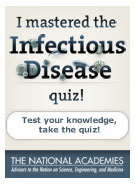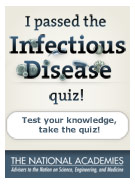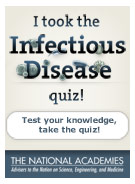
What You Need To Know About Infectious Disease
What do you know about infectious disease?
True or False: Washing your hands with soaps that have residue-producing antibacterial products, such as those containing the chemical triclosan, have been proven to confer health benefits.
-
Sorry, that’s incorrect.
Washing with regular soap is considered the most important way to prevent disease transmission. Routine consumer use of residue-producing antibacterial products has no added benefit and may actually contribute to antibiotic resistance.
-
Correct!
Washing with regular soap is considered the most important way to prevent disease transmission. Routine consumer use of residue-producing antibacterial products has no added benefit and may actually contribute to antibiotic resistance.
True or False: If you have a cold or the flu, taking antibiotics will help treat the infection.
-
Sorry, that’s incorrect.
Antibiotics only work on bacterial infections, not viral infections such as influenza and the common cold. In fact, inappropriate use and overuse of antibiotics contributes to the emergence of drug-resistant bacteria.
-
Correct!
Antibiotics only work on bacterial infections, not viral infections such as influenza and the common cold. In fact, inappropriate use and overuse of antibiotics contributes to the emergence of drug-resistant bacteria.
Which of the following is an effective way to protect yourself against infectious disease?
- Keep immunizations up to date
- Wash your hands often
- Prepare and handle food carefully
- All of the above
-
Sorry, that’s incorrect.
All of the above can help prevent infectious disease. Other behaviors, such as exercising caution around wild and unfamiliar domestic animals, avoiding insect bites, practicing safe sex, and being vigilant about disease threats while traveling abroad, can also reduce the risk of infection.
-
Sorry, that’s incorrect.
All of the above can help prevent infectious disease. Other behaviors, such as exercising caution around wild and unfamiliar domestic animals, avoiding insect bites, practicing safe sex, and being vigilant about disease threats while traveling abroad, can also reduce the risk of infection.
-
Sorry, that’s incorrect.
All of the above can help prevent infectious disease. Other behaviors, such as exercising caution around wild and unfamiliar domestic animals, avoiding insect bites, practicing safe sex, and being vigilant about disease threats while traveling abroad, can also reduce the risk of infection.
-
Correct!
All of the above can help prevent infectious disease. Other behaviors, such as exercising caution around wild and unfamiliar domestic animals, avoiding insect bites, practicing safe sex, and being vigilant about disease threats while traveling abroad, can also reduce the risk of infection.
Which of the following diseases kills more children worldwide than any other infectious disease?
- Lower respiratory tract infections (including pneumonia)
- HIV/AIDS
- Diarrheal diseases
- Tuberculosis
- Malaria
-
Correct!
Lower respiratory tract infections (including pneumonia) kill more children worldwide than any other infectious disease. Together these diseases are the five leading causes of infectious disease worldwide, accounting for nearly one-fifth of all deaths.
-
Sorry, that’s incorrect.
Lower respiratory tract infections (including pneumonia) kill more children worldwide than any other infectious disease. Together these diseases are the five leading causes of infectious disease worldwide, accounting for nearly one-fifth of all deaths.
-
Sorry, that’s incorrect.
Lower respiratory tract infections (including pneumonia) kill more children worldwide than any other infectious disease. Together these diseases are the five leading causes of infectious disease worldwide, accounting for nearly one-fifth of all deaths.
-
Sorry, that’s incorrect.
Lower respiratory tract infections (including pneumonia) kill more children worldwide than any other infectious disease. Together these diseases are the five leading causes of infectious disease worldwide, accounting for nearly one-fifth of all deaths.
-
Sorry, that’s incorrect.
Lower respiratory tract infections (including pneumonia) kill more children worldwide than any other infectious disease. Together these diseases are the five leading causes of infectious disease worldwide, accounting for nearly one-fifth of all deaths.
Which are larger?
-
Correct!
Bacteria are 10 to 100 times larger than viruses.
-
Sorry, that’s incorrect.
Bacteria are 10 to 100 times larger than viruses.
True or False: Not all microbes are harmful to humans.
-
Correct!
Not all microbes are harmful to humans. In fact, many of them protect us, helping our bodies function properly and competing with harmful organisms in an eternal contest for habitable space in or on our bodies. Although the microorganisms that cause disease often receive more attention, most microorganisms do not cause illness.
-
Sorry, that’s incorrect.
Not all microbes are harmful to humans. In fact, many of them protect us, helping our bodies function properly and competing with harmful organisms in an eternal contest for habitable space in or on our bodies. Although the microorganisms that cause disease often receive more attention, most microorganisms do not cause illness.
For each child who dies from pneumonia in an industrialized country, about how many children die from the infection in developing countries?
-
Sorry, that’s incorrect.
Life-saving vaccines and medications aren’t distributed equitably around the world; for each child who dies from pneumonia in an industrialized country, more than 2,000 children die from the infection in developing countries.
-
Sorry, that’s incorrect.
Life-saving vaccines and medications aren’t distributed equitably around the world; for each child who dies from pneumonia in an industrialized country, more than 2,000 children die from the infection in developing countries.
-
Sorry, that’s incorrect.
Life-saving vaccines and medications aren’t distributed equitably around the world; for each child who dies from pneumonia in an industrialized country, more than 2,000 children die from the infection in developing countries.
-
Correct!
Life-saving vaccines and medications aren’t distributed equitably around the world; for each child who dies from pneumonia in an industrialized country, more than 2,000 children die from the infection in developing countries.
If you have strep throat, which of the following forms of medication can be used to effectively treat the infection?
-
Sorry, that’s incorrect.
Because strep throat is caused by a bacterium called Streptococcus pyogenes, it is treatable with antibiotics but not antivirals. Currently there is no vaccine available to prevent strep throat.
-
Correct!
Because strep throat is caused by a bacterium called Streptococcus pyogenes, it is treatable with antibiotics but not antivirals. Currently there is no vaccine available to prevent strep throat.
-
Sorry, that’s incorrect.
Because strep throat is caused by a bacterium called Streptococcus pyogenes, it is treatable with antibiotics but not antivirals. Currently there is no vaccine available to prevent strep throat.
-
Sorry, that’s incorrect.
Because strep throat is caused by a bacterium called Streptococcus pyogenes, it is treatable with antibiotics but not antivirals. Currently there is no vaccine available to prevent strep throat.
True or False: Growing evidence suggests that infections are behind many chronic diseases once thought to be caused by genetic, environmental, or lifestyle factors.
-
Correct!Growing evidence does suggest that infections are behind many chronic diseases once thought to be caused by genetic, environmental, or lifestyle factors, including peptic ulcers and cervical, liver, and gastric cancers.
-
Sorry, that’s incorrect.
Growing evidence does suggest that infections are behind many chronic diseases once thought to be caused by genetic, environmental, or lifestyle factors, including peptic ulcers and cervical, liver, and gastric cancers.
Thank you for taking our quiz.
Place this badge on your Facebook page to show your friends what you know about infectious disease.
Place this badge on your Facebook page to show your friends what you know about infectious disease.
OR, get a higher score to unlock a different badge.
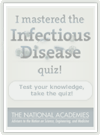
Place this badge on your Facebook page to show your friends what you know about infectious disease.
OR, get a higher score to unlock a different badge.
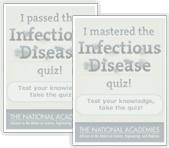
Explore Other Topics
Disease Watchlist
Infectious Disease Defined
- Antibodies
A class of drugs used to kill or inhibit the growth of disease-causing microorganisms. Typically antibiotics are used to treat infections caused by bacteria, but in some cases they are also used against other microorganisms, such as fungi and protozoa.
